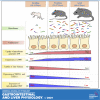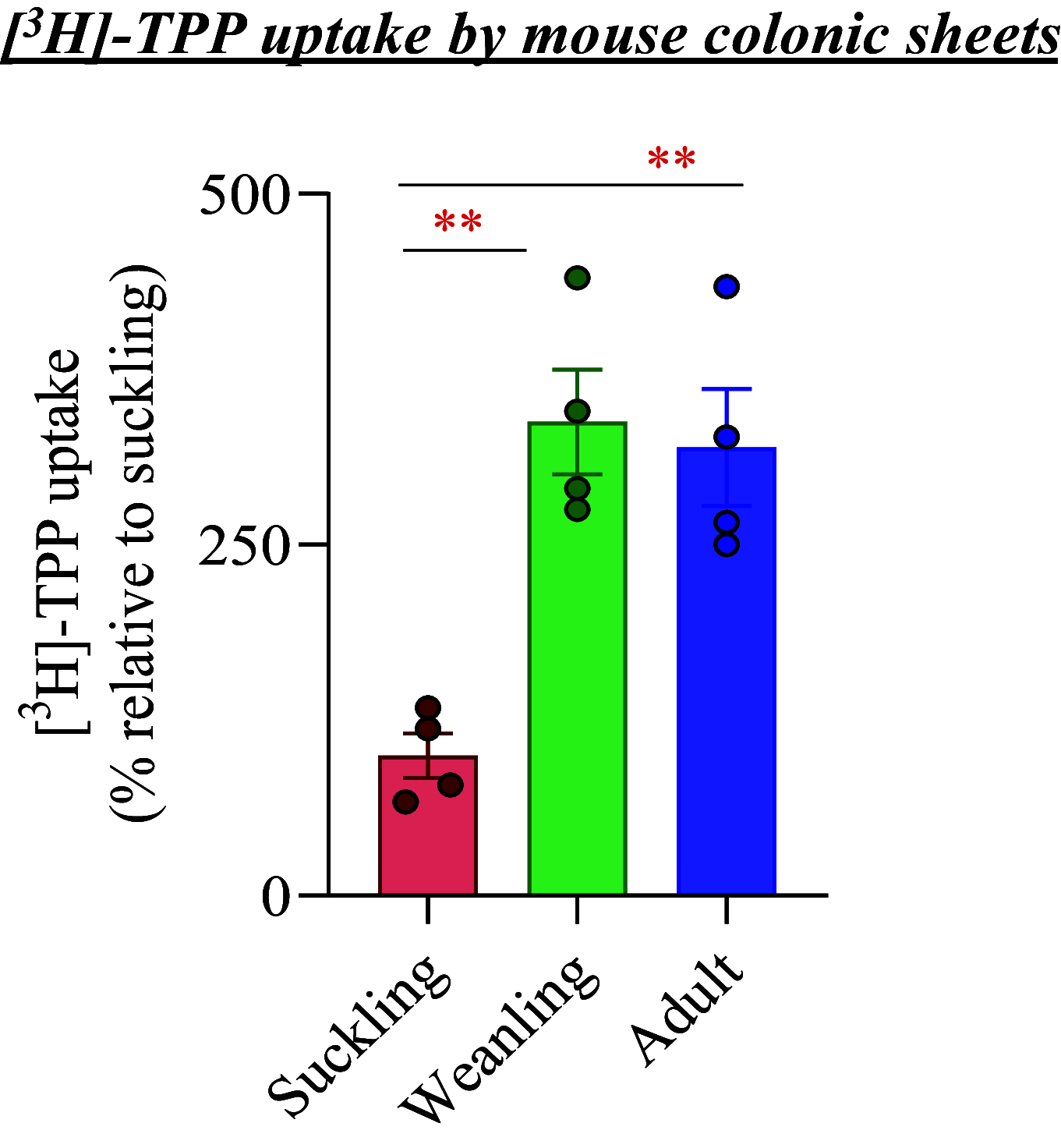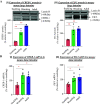Developmental maturation of the colonic uptake process of the microbiota-generated thiamin pyrophosphate
- PMID: 33759569
- PMCID: PMC8202194
- DOI: 10.1152/ajpgi.00067.2021
Developmental maturation of the colonic uptake process of the microbiota-generated thiamin pyrophosphate
Abstract
The water-soluble vitamin B1 is essential for normal human health and physiology. In its main biologically active form, i.e., thiamin pyrophosphate (TPP), the vitamin plays many critical roles in cell metabolism; thus, its deficiency leads to a variety of adverse effects. Humans/mammals obtain vitamin B1 from two exogenous sources: diet and gut microbiota. Considerable amount of the microbiota-generated vitamin B1 exists in the form of TPP, and colonocytes can efficiently absorb this TPP via a high-affinity and specific carrier-mediated mechanism that involves the recently cloned colonic TPP transporter (cTPPT; product of SLC44A4 gene). There is nothing currently known about colonic uptake of TPP during early stages of life and whether the process undergoes developmental regulation. We addressed this issue using the mouse as animal model. Our results showed that colonic uptake of TPP undergoes developmental upregulation as the animal moves from the suckling period to weanling and adulthood. This upregulation in uptake was found to be associated with a parallel induction in level of expression of the cTPPT protein, mRNA, and heterogeneous nuclear RNA, suggesting possible involvement of transcriptional mechanism(s). We also found a parallel upregulation in the level of expression of the two nuclear factors that drive activity of the SLC44A4 promoter (i.e., CREB-1 and Elf-3) with maturation. These results demonstrate, for the first time, to our knowledge, that colonic TPP uptake process and cTPPT expression are developmentally upregulated and that this upregulation is likely driven via transcriptional mechanism(s).NEW & NOTEWORTHY The colonic carrier-mediated uptake process of the microbiota-generated and phosphorylated form of vitamin B1, i.e., thiamin pyrophosphate, undergoes ontogenic changes that parallel the development of the gut microbiota (and their ability to generate vitamins) during early stages of life.
Keywords: colonic uptake; developmental maturation; gut microbiota; ontogenic regulation; thiamin pyrophosphate.
Conflict of interest statement
No conflicts of interest, financial or otherwise, are declared by the authors.
Figures





Similar articles
-
Effect of knocking out mouse Slc44a4 on colonic uptake of the microbiota-generated thiamine pyrophosphate and colon physiology.Am J Physiol Gastrointest Liver Physiol. 2024 Jul 1;327(1):G36-G46. doi: 10.1152/ajpgi.00065.2024. Epub 2024 May 7. Am J Physiol Gastrointest Liver Physiol. 2024. PMID: 38713615 Free PMC article.
-
Bacterial lipopolysaccharide inhibits colonic carrier-mediated uptake of thiamin pyrophosphate: roles for TLR4 receptor and NF-κB/P38/JNK signaling pathway.Am J Physiol Cell Physiol. 2023 Sep 1;325(3):C758-C769. doi: 10.1152/ajpcell.00272.2023. Epub 2023 Jul 31. Am J Physiol Cell Physiol. 2023. PMID: 37519229 Free PMC article.
-
Enterohemorrhagic Escherichia coli infection inhibits colonic thiamin pyrophosphate uptake via transcriptional mechanism.PLoS One. 2019 Oct 22;14(10):e0224234. doi: 10.1371/journal.pone.0224234. eCollection 2019. PLoS One. 2019. PMID: 31639155 Free PMC article.
-
The THI-box riboswitch, or how RNA binds thiamin pyrophosphate.Structure. 2007 Mar;15(3):259-65. doi: 10.1016/j.str.2007.02.001. Structure. 2007. PMID: 17355861 Review.
-
Identification of novel ligands for thiamine pyrophosphate (TPP) riboswitches.Biochem Soc Trans. 2011 Apr;39(2):652-7. doi: 10.1042/BST0390652. Biochem Soc Trans. 2011. PMID: 21428956 Review.
Cited by
-
High-resolution plasma metabolomics and thiamine status in critically Ill adult patients.Metabolomics. 2024 Jul 27;20(4):83. doi: 10.1007/s11306-024-02144-9. Metabolomics. 2024. PMID: 39066851 Free PMC article.
-
Dietary fibers boost gut microbiota-produced B vitamin pool and alter host immune landscape.Microbiome. 2024 Sep 23;12(1):179. doi: 10.1186/s40168-024-01898-7. Microbiome. 2024. PMID: 39307855 Free PMC article.
-
Ketogenic Diet: A Dietary Intervention via Gut Microbiome Modulation for the Treatment of Neurological and Nutritional Disorders (a Narrative Review).Nutrients. 2022 Aug 30;14(17):3566. doi: 10.3390/nu14173566. Nutrients. 2022. PMID: 36079829 Free PMC article. Review.
-
Transporters in vitamin uptake and cellular metabolism: impacts on health and disease.Life Metab. 2025 Mar 10;4(3):loaf008. doi: 10.1093/lifemeta/loaf008. eCollection 2025 Jun. Life Metab. 2025. PMID: 40444179 Free PMC article. Review.
References
-
- Hernandez-Vazquez AJ, Garcia-Sanchez JA, Moreno-Arriola E, Salvador-Adriano A, Ortega-Cuellar D, Velazquez-Arellano A. Thiamine deprivation produces a liver ATP deficit and metabolic and genomic effects in mice: findings are parallel to those of biotin deficiency and have implications for energy disorders. J Nutrigenet Nutrigenomics 9: 287–299, 2016. doi:10.1159/000456663. - DOI - PubMed
-
- Fernandez-Banares F, Abad-Lacruz A, Xiol X, Gine JJ, Dolz C, Cabre E, Esteve M, Gonzalez-Huix F, Gassull MA. Vitamin status in patients with inflammatory bowel disease. Am J Gastroenterol 84: 744–748, 1989. - PubMed
Publication types
MeSH terms
Substances
Grants and funding
LinkOut - more resources
Full Text Sources
Other Literature Sources

